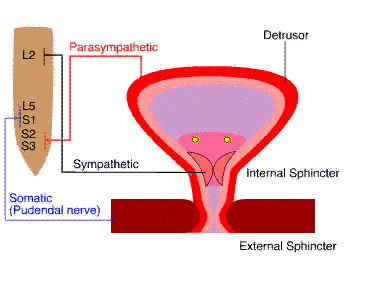4 Requirements for Normal Voiding
1. Average Bladder Capacity 350-550 cc.
In the elderly, the capacity may decrease to 250 - 300 cc.
Approximately 150-250 cc may be stored (less in the elderly) before there
is a sensation of bladder pressure. As the bladder fills beyond 150-250 mL the individual begins toilet seeking.
2. Anatomical integrity of the bladder, urethra and external sphincter.

The bladder and external sphincter actvity must be coordinated to store and release urine.
The healthy bladder muscle (detrusor) is stable and does not contract until the person
relaxes the external sphincter. Post void residual (PVR) of 50 to 100 mL is generally accepted as normal in the elderly. The
literature suggests that younger people empty their bladder every 4 to 5 hours
and older people empty their bladder every 3 to 4 hours within a 24 hour period.
Instant Feedback:
The
bladder tends to increase in capacity with increased age
3. Intact neurological system to provide voluntary and coordinated
voiding.
Complex feedback loops involving the frontal lobe of the brain, the sacral reflex center in the spinal cord and the sphincter interact to complete the
voiding cycle. Click
here for an indepth review of the micturition mechanism
4. Physical and mental capacity to perform
the tasks associated with voiding.
- Mental
- Able to identify need to void.
- Can locate an appropriate place to urinate.
- Physical
- Has the mobility to get to toilet.
- Can remove clothing as necessary.
Click here for overview of
the age-related changes affecting this complex voiding cycle.
Instant Feedback:
It's
normal for the elderly to have more than 100 cc left in the bladder after voiding.
© RnCeus.com
